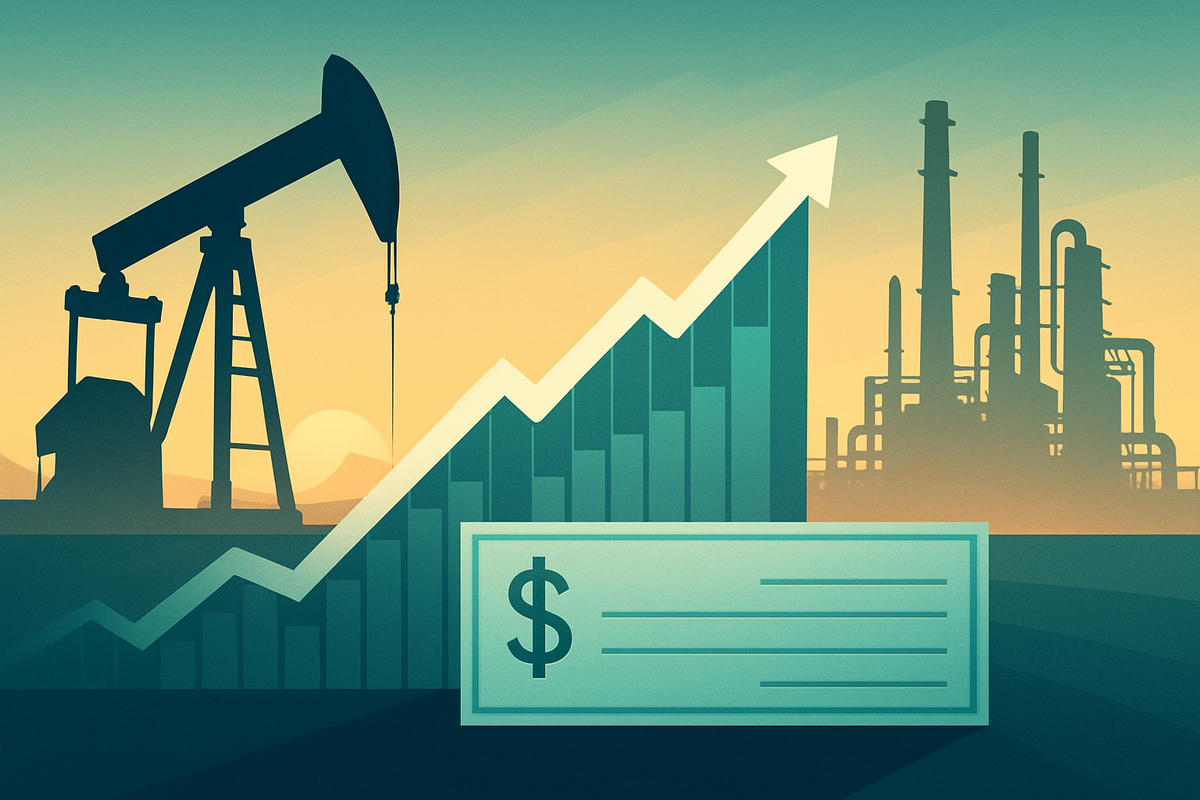
New York, NY – October 13, 2025 – In a financial landscape often characterized by rapid shifts and unpredictable turns, the consistent declaration of quarterly dividends by corporate giants like Exxon Mobil Corporation (NYSE: XOM) serves as a reassuring beacon for investors. While the specific amount of Exxon Mobil's next dividend, anticipated around October 31, 2025, is yet to be announced, the very act of its regular declaration underscores a profound message of financial resilience and commitment to shareholder returns. This steadfast approach is particularly compelling, offering a sense of predictability and a tangible return on investment that remains attractive amidst broader market uncertainties.
For income-focused investors, the mere expectation of a forthcoming dividend from a company with Exxon Mobil's pedigree is a significant event. It speaks volumes about the company's robust cash flow generation and its management's confidence in its ongoing profitability, regardless of the fluctuating energy market. This consistent payout strategy positions Exxon Mobil as a cornerstone holding for portfolios prioritizing stable income and long-term wealth accumulation, making each dividend announcement, even a routine one, a moment of reinforcement for its investor base.
A Legacy of Returns: Understanding Exxon Mobil's Dividend Strategy
Exxon Mobil's dividend policy is a testament to its long-term financial discipline and its position as a leading global energy producer. The company has an impressive track record, having increased its dividend for 43 consecutive years, a remarkable feat that places it in an elite group of dividend aristocrats and kings. The most recent quarterly dividend of $0.99 per share was declared on August 1, 2025, with a payment date of September 10, 2025, to shareholders of record as of August 15, 2025. This historical consistency is a critical factor in why investors closely monitor these announcements.
The process typically involves the company's board of directors meeting to review financial performance and approve the dividend declaration. For Exxon Mobil, these declarations usually occur in the months preceding the payment. Key players involved are the company's executive management, who recommend the dividend, and the board, which approves it. Shareholders are the primary stakeholders, directly benefiting from these payouts. Initial market reactions to routine dividend declarations from a company with such a strong history are generally positive, or at least neutral, reinforcing investor confidence in the stock as a reliable income generator. Any deviation from this pattern, however, would likely trigger significant market scrutiny.
The anticipated declaration around October 31, 2025, for a December payment, aligns perfectly with Exxon Mobil's established rhythm. This predictable schedule allows investors to plan their income streams and evaluate their investment strategies with a high degree of certainty. In an industry prone to commodity price swings, this unwavering commitment to shareholder returns stands out as a core pillar of Exxon Mobil's investment thesis, attracting both institutional funds seeking stable returns and individual investors building long-term portfolios.
Navigating the Dividend Landscape: Winners and Losers
The consistent declaration of a quarterly dividend by Exxon Mobil (NYSE: XOM) primarily benefits its existing shareholders, particularly those who rely on income from their investments. For long-term holders, retirees, and income funds, these regular payouts provide a predictable cash flow stream, bolstering their financial stability. Shareholders also win through the potential for dividend reinvestment, allowing them to acquire more shares without additional capital outlay, thereby compounding their returns over time. The perception of financial strength and reliability associated with a consistent dividend payer can also attract new investors looking for stable, income-generating assets, potentially leading to increased demand for XOM shares.
Conversely, there are few direct "losers" from a routine dividend declaration, as it generally signals corporate health. However, companies that operate with less robust cash flows or inconsistent dividend policies might indirectly "lose" in comparison, as investors may favor the stability offered by Exxon Mobil. In a broader sense, companies that are heavily reinvesting all their earnings back into growth, and therefore not paying dividends, might be seen as less attractive to income-focused investors, especially during periods of market volatility when tangible returns are highly valued.
The energy sector as a whole can also see a ripple effect. When a major player like Exxon Mobil demonstrates consistent financial strength through its dividend, it can lend credibility to the sector's overall health, potentially benefiting other stable, dividend-paying energy companies. However, for smaller, more volatile energy firms, Exxon Mobil's steadfastness can highlight their own comparative instability, potentially making it harder for them to attract certain types of investors. Ultimately, Exxon Mobil's dividend acts as a benchmark, setting a high standard for shareholder returns within the industry.
Broader Implications: Exxon Mobil's Dividend in the Energy Tapestry
Exxon Mobil's unwavering commitment to its quarterly dividend is not merely a corporate decision; it's a significant indicator within the broader energy industry. It underscores a prevailing trend among mature, integrated oil and gas companies to prioritize shareholder returns through consistent dividends and share buybacks, even as they navigate the complexities of energy transition. This strategy reflects a recognition that while future growth avenues are being explored, the core business remains a powerful cash generator that can reward investors today. This approach contrasts with some newer energy ventures or renewable energy companies that focus solely on reinvesting profits for aggressive growth, often foregoing dividends.
The ripple effects of Exxon Mobil's dividend extend to competitors and partners. For other oil majors like Chevron (NYSE: CVX) or Shell (NYSE: SHEL), Exxon Mobil's dividend record sets a high bar, influencing their own capital allocation strategies and their perceived attractiveness to income investors. Partners in joint ventures also benefit from Exxon Mobil's financial stability, as it signals a reliable partner capable of fulfilling its commitments. From a regulatory and policy perspective, a strong, dividend-paying energy sector can contribute to economic stability, which governments generally favor. However, it also highlights the ongoing profitability of fossil fuel companies, which can intensify debates around environmental policies and taxation in some regions.
Historically, consistent dividend payments from industrial giants have been a hallmark of economic stability. Exxon Mobil's long history of dividend growth, including through various economic cycles and oil price shocks, provides a robust precedent. It demonstrates that even in a cyclical industry, strategic financial management can ensure sustained shareholder returns. This resilience is a key factor that differentiates established energy giants from smaller, more speculative players, cementing their role as foundational elements of many investment portfolios.
The Road Ahead: What's Next for Exxon Mobil's Dividend Strategy
Looking ahead, the short-term outlook for Exxon Mobil's (NYSE: XOM) dividend strategy is one of continued consistency. Investors can reasonably expect the company to declare its next quarterly dividend around the end of October 2025, maintaining its long-standing pattern. The crucial element for investors will be whether the company continues its impressive streak of dividend increases, even if modest. This commitment to growth, however small, is a powerful signal of confidence in future earnings and cash flow. In the long term, Exxon Mobil will need to balance its dividend commitments with its strategic pivots towards lower-carbon energy solutions and continued investments in its traditional oil and gas business.
Potential strategic adaptations for Exxon Mobil may include adjusting the pace of dividend increases based on commodity price volatility, capital expenditure requirements for new projects (including those in renewables), and debt management. The company's ability to maintain a strong balance sheet while funding both its traditional and new energy ventures will be paramount. Market opportunities may emerge from its advancements in carbon capture, hydrogen, and biofuels, which could open new revenue streams that further support its dividend capacity. Challenges include navigating evolving environmental regulations, geopolitical risks impacting oil supply, and the inherent volatility of energy prices.
Potential scenarios range from a continued steady increase in dividends, reflecting strong operational performance and disciplined capital allocation, to a plateauing of dividend growth if significant capital is diverted to large-scale energy transition projects. A less likely, but always possible, scenario would be a dividend cut, which would only occur under severe and sustained financial distress, a situation that Exxon Mobil's robust financial position currently makes improbable. Investors should closely watch the company's earnings calls for guidance on capital allocation and long-term strategic priorities.
A Pillar of Stability: Wrapping Up Exxon Mobil's Dividend Narrative
Exxon Mobil's (NYSE: XOM) consistent declaration of quarterly dividends stands as a critical takeaway for investors, underscoring the company's financial strength and its unwavering commitment to shareholder returns. Even without a specific new amount, the expectation of a forthcoming dividend, particularly from a company with a 43-year history of increases, signals robust cash flow and management confidence. This predictability offers a valuable anchor in an often-turbulent market, making XOM an attractive proposition for income-seeking investors and those prioritizing long-term portfolio stability.
Moving forward, the market will continue to assess Exxon Mobil's ability to maintain its dividend growth trajectory while simultaneously investing in its future through energy transition initiatives. The company's strategic decisions regarding capital allocation between traditional oil and gas projects and new energy ventures will be crucial in determining the sustainability of its dividend policy. Its capacity to generate strong free cash flow will remain the bedrock of its ability to reward shareholders.
Investors should closely monitor Exxon Mobil's quarterly earnings reports, management commentary on future capital expenditure, and any updates on its energy transition projects. These insights will provide crucial context for the dividend's future trajectory and the company's overall financial health. Ultimately, Exxon Mobil's dividend is more than just a payment; it's a powerful statement about its enduring position in the global energy landscape and its dedication to delivering consistent value to its shareholders.
This content is intended for informational purposes only and is not financial advice


















